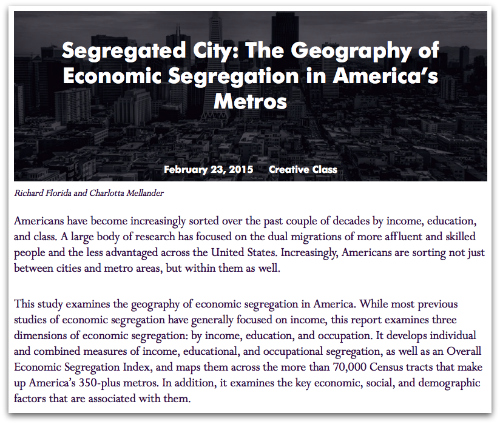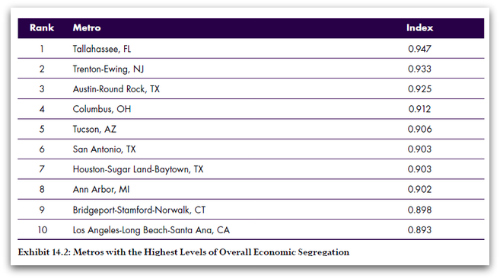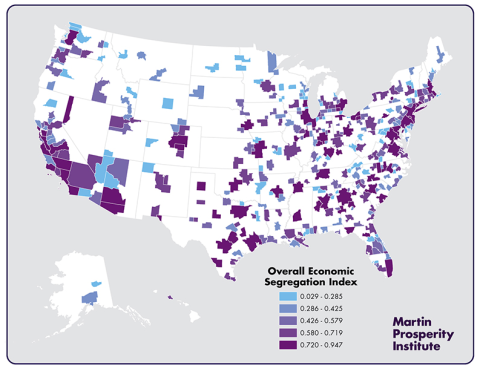Somehow, a year or so ago, I fell into groove where I started talking with local musicians about vacations they’d taken outside of Michigan. I’m not sure what prompted it, or why I suddenly stopped, but I suspect it was weather related to some degree. And, now that it’s 20 degrees below zero outside, I guess I’m getting the itch once again to explore, or at least think about, other places. So, with that in mind, when I heard a few days ago that local violin player, singer and actress Carol Catherine fell in love with Las Vegas on a recent to Nevada, I thought that I’d track her down and ask her to talk… What follows is our conversation.
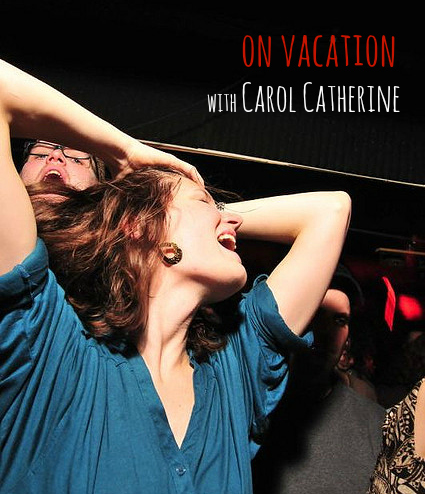
MARK: Is Catherine a last name, or the second part of a first name? And, if it’s the latter, do you have a last name? And, if so, why don’t you use it? Are you hiding from something?
CAROL CATHERINE: Catherine is my first middle name. My whole name is Carol Catherine Burns Gray. I honestly don’t remember when I started using it… I think it was when I first got a MySpace profile, approximately 75 years ago… I was a little embarrassed about it, and thought I could disguise myself by using this VERY SECRET PEN NAME, which was also actually part of my real name. And then it just stuck. And then I thought I could start using it as my stage name, which I do sometimes. Carol Gray used to bore me; it sounded so austere and proper to me, which is the opposite of my personality as a performer. But actually I like it now. It’s old school.
MARK: I know it’s spelled differently, but it’s Fifty Shades of Grey that made you see the last name as less boring, right? I won’t judge you…
CAROL CATHERINE: Hah! A lady never reveals such details… but yes.
MARK: I’m told that you’re descended from witches?
CAROL CATHERINE: Family legend has it that I’m descended from Rebecca Nurse, who was executed in 1692 during the Salem witch trials. She was a pretty interesting person, by most accounts incredibly pious and devoted to her neighbors and community, and was basically executed over a property dispute with a neighbor who coerced young women into pretending to have fits in her presence. The wife of the neighbor later publicly apologized to the Nurse family. I think she has a memorial site and everything. And of course she’s a character in Miller’s play, The Crucible .
.
MARK: To quote Charles Manson, do you ever feel “witchy”?
 CAROL CATHERINE: I suppose so, although let’s recall that Rebecca Nurse was not *actually* a witch. I do sometimes feel wrongfully accused… Also I have a lot of vintage clothes that I bought specifically to look more like Stevie Nicks; does that count? [Nurse is depicted right in the book “The Witch of Salem” by John R. Musick.]
CAROL CATHERINE: I suppose so, although let’s recall that Rebecca Nurse was not *actually* a witch. I do sometimes feel wrongfully accused… Also I have a lot of vintage clothes that I bought specifically to look more like Stevie Nicks; does that count? [Nurse is depicted right in the book “The Witch of Salem” by John R. Musick.]
MARK: Wait, so the woman that were killed in Salem weren’t actually witches?
CAROL CATHERINE: I know, can you believe it? And people were SO SURE. I wonder what lessons we can learn from that…
MARK: Seriously, what’s the deal with the Salem witch trials? I believe I’d heard it suggested in the past that it might have started with doctors feeling threatened by the growing power of midwives in the community, which sounds plausible. I can see how some powerful man in Salem could have accused someone that he didn’t like of being a witch, just to get rid of her. I mean, we’ve heard numerous stories over the past decade or so of people in Iraq having been falsely accused of terrorism by neighbors who didn’t like them – neighbors who saw an opportunity to get rid of them when American forces came in, asking for informants to come forward and name names. And, maybe, once that door was opened, people just couldn’t help but look at their neighbors with suspicion… It’s really fascinating stuff.
CAROL CATHERINE: I totally agree, it is fascinating. The propensity of people to just go with the crowd; to get caught up in the panic of suspicion and blame. And that kind of community bullying (perhaps an overused term, but the shoe fits) usually ends up reinforcing really awful parts of the status quo that can have a huge impact on generations of people. But it feels so safe to go along with the status quo. It’s much easier. To me that really speaks to the courage it takes to stand up against the mainstream wave and let your own morality be your compass. This isn’t exactly original thinking here. But I’m interested in the people who find it within themselves to do that. I want to know their stories. The Nurse family set up a memorial to the 20 or so neighbors and friends of Rebecca Nurse who signed a petition on her behalf to try and halt the court proceedings against her. They knew the witchcraft thing was bullshit and they stood up for her. And it wasn’t enough, which is tragic, but the fact they have a memorial – we should have more memorials for people like that.
MARK: I’m sure it gets to a point where you start thinking, “If I don’t point out someone as a witch soon, it’s just a matter of time before someone says I’m a witch.” Given that, it’s truly amazing to me that she actually had friends who stood up alongside her, and fought for her, in that environment.
CAROL CATHERINE: Right, it’s about fear for our own safety and reputation. But the interesting question to me is what makes us safe? Does executing people or removing people from society really make us safer? What does “safe” really mean, anyway? It’s easy to imagine that dangerous people are inherently dangerous, that danger and risk exist in some kind of static state – you’re either bad, or good. But of course, and thank god for this, life is not like that. People aren’t one or the other. We’re all both. Maybe the people who stood up for Rebecca understood that.
MARK: Have you ever thought of taking some time and exploring Salem?
CAROL CATHERINE: That would be a great vacation. My great uncle lived and worked in Williamstown, MA, and I’ve spent a ton of time there. It is, however, nowhere near Salem, so every trip I’ve taken out east hasn’t quite offered up that opportunity. But I would love to visit, to see the memorial, maybe wear a Stevie Nicks outfit, you know, get back to my roots.
MARK: The purpose of this interview series is to talk with musicians about vacations that they’ve already taken, but I feel as though we should send you to Salem and have you report back… I just wish I had a budget…
CAROL CATHERINE: I’ll do it for free. As long as there’s no deadline!
MARK: I’ve tried to kill the blog a few times over the past dozen years, and I’ve never been able to do it. So, I think you’ve got time… Unless, of course, something terrible happens to me… But maybe, in that case, my ten year old daughter will take over for me. I’ve been grooming her for it. So, no, don’t worry about a deadline.
CAROL CATHERINE: I bet she would really whip this into shape.
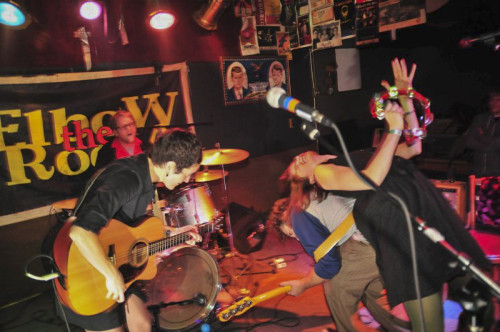
[That’s Carol Catherine to the right, performing with Misty Lyn Bergeron at Mittenfest III. Photo by Doug Coombe.]
MARK: I heard you were in Las Vegas not too long ago. What took you there? A convention? Gambling addiction? Wedding? Some combination of the three?
CAROL CATHERINE: I actually hate gambling, mostly because I’m bad at it. I went for a week during my spring break when I was in grad school, in 2013. I had never been there and Ryan, my partner, loves it and has been there multiple times. His mom used to work for a travel agency, and he would get to go on the cheap when he was younger. And I think it’s one of those magical places that, once it gets its hooks in you, you’re hooked for life. Or, I suppose, you completely hate it. Which I thought I would. But I didn’t! I loved it. It’s a weird, unique, wild, creative place.
MARK: I guess I’m more in the “completely hate it” camp. I just don’t get it. It’s so artificial. I don’t get any sense of real culture, or history… just facades constructed to invoke such things. But I’m willing to be convinced. What is it that you love about Vegas?
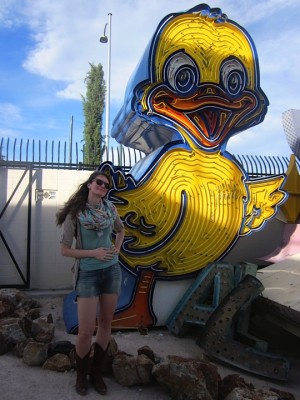 CAROL CATHERINE: Well, it’s completely unnatural, you’re right. But what a fascinating place! Humans – we go where we don’t belong and claim everything we can in our name. We don’t work for the earth, we make the earth work for US! Las Vegas is like the ultimate expression of manifest destiny, to me. Being there was very much like being on another planet. You don’t know your way around and everything is alien, and the desert just encroaches on all sides, like it’s waiting to makes its move. Like you’re just waiting for the ground beneath you to realize it’s been played. You tread lightly. But there’s neon and glitter and excess and daiquiris and you kind of feel like every night is the last night on earth. So there’s this mystique surrounding it, to me, which is really interesting. [Carol Catherine right at the Neon Museum of Las Vegas.]
CAROL CATHERINE: Well, it’s completely unnatural, you’re right. But what a fascinating place! Humans – we go where we don’t belong and claim everything we can in our name. We don’t work for the earth, we make the earth work for US! Las Vegas is like the ultimate expression of manifest destiny, to me. Being there was very much like being on another planet. You don’t know your way around and everything is alien, and the desert just encroaches on all sides, like it’s waiting to makes its move. Like you’re just waiting for the ground beneath you to realize it’s been played. You tread lightly. But there’s neon and glitter and excess and daiquiris and you kind of feel like every night is the last night on earth. So there’s this mystique surrounding it, to me, which is really interesting. [Carol Catherine right at the Neon Museum of Las Vegas.]
MARK: The sand will eventually overtake the city. “Sand grows. Sand crawls”… Sorry for the Errol Morris reference, but I can’t help myself.
CAROL CATHERINE: Love that man. I was thinking more, “walk without rhythm so the worms don’t hear.” Frank Herbert must have been to Vegas.
MARK: It’s difficult to imagine that people actually want to make their homes there…
CAROL CATHERINE: I remember exploring the town a little bit and realizing people, like, LIVE there. There are public schools and kids and cemeteries and corner stores. That hadn’t occurred to me before; I just thought of Vegas as the strip. But there’s a lot more to it than that. An incredibly rich history of military families and atomic testing and environmental research, believe it or not. In fact, Ryan’s grandfather was in the Air Force and was stationed in Vegas in the 50s, and his mom remembers being a kid there, and watching the atomic tests they would do in the desert just outside the city. People would literally set up lawn chairs and put on sunglasses and just watch these huge explosions.
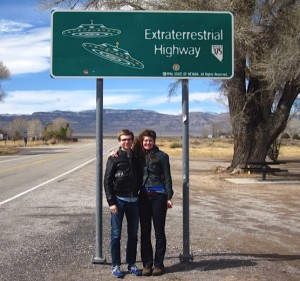 We spent a lot of time outside the strip, looking at the desert and riding ponies along the canyon. And we spent a day visiting Area 51, which, for a former X-Phile (me) and a conspiracy theorist (him), was quite the exciting adventure. And of course there’s the performances – people come from all over the world to play Vegas! And the FOOD! I had the best meal of my life there. [Ryan and Carol Catherine (right) on the way to Area 51.]
We spent a lot of time outside the strip, looking at the desert and riding ponies along the canyon. And we spent a day visiting Area 51, which, for a former X-Phile (me) and a conspiracy theorist (him), was quite the exciting adventure. And of course there’s the performances – people come from all over the world to play Vegas! And the FOOD! I had the best meal of my life there. [Ryan and Carol Catherine (right) on the way to Area 51.]
MARK: I want to hear more about Las Vegas, but, before we get too deep into it, let’s talk a bit about music. Do you remember your first public performance?
CAROL CATHERINE: It was a show that Chris Bathgate did in the basement of the old Frieze building, back when Basement Arts had a little blackbox theater down there. I miss that place. Anyway, I think he was completing a thesis in poetry or something, and he had decided that his final project would be setting his poems to music, which became this beautiful album, Silence is for Suckers. I was hanging out with him and a few friends one night, this was maybe in 2004/2005, probably on the porch of 609 Ann Street, which was this wonderful, terrible den of sin, and I mentioned that I used to play the violin. I had played when I was a kid, but gave it up. And he asked me if I would be willing to be a part of the performance. He explained that all I would have to do was stand up in the middle of the audience, at a designated time in the set, and play weird noises that were vaguely in tune with the three other violinists he had recruited. And because the wine we were drinking had made me fearless, I said yes. I remember going home that night and thinking, “What did I just agree to?” But it turned out beautifully. And not long after that I joined a band he started with Matt Jones, among others, called Descent of the Holy Ghost Church, and the rest is history.

[Carol Catherine performing with Matt Jones at the Ark. Photo courtesy of Doug Coombe.]
MARK: Not too long ago, I interviewed a Matt Jones here about his obsession with the Civil War. As you often perform with Matt, I’m curious as to how this obsession of his has affected you. Do I understand correctly that he makes you read things about the Civil War on stage?
CAROL CATHERINE: He does make me read things on stage, but it doesn’t bother me. Honestly, his obsession has rubbed off a little bit on me, and probably everyone else who knows him. He’s like a one man champion for the fallen soldiers of that era. It’s hard not to be interested in it. And the things he makes me read are incredibly powerful. I can’t get through Sullivan Ballou’s letter to Sarah without weeping.
MARK: Can you share a line or two?
CAROL CATHERINE: The whole thing is worth reading… to give a little context, this is a letter that this soldier wrote to his wife from the battlefield. And he wasn’t able to send it – he died before he could post it. They found it in his jacket. My favorite part (and the part that ruins me, every time) is the following passage: “If the dead can come back to this earth and flit unseen around those they loved, I shall always be near you; in the gladdest days and in the darkest nights… always, always, and if there be a soft breeze upon your cheek, it shall be my breath, as the cool air fans your throbbing temple, it shall be my spirit passing by. Sarah do not mourn me dead; think I am gone and wait for thee, for we shall meet again…”
MARK: Damn. That’s pretty incredible… Now we’d just text an emoticon of some kind.
CAROL CATHERINE: Seriously. Maybe just an away message. “brb soldiering.” “Sullivan Ballou is offline.”
MARK: Is there any truth to the rumor that you once forgot your violin, and had to sing all of your violin parts?
CAROL CATHERINE: One of my finer moments. It was the first headlining gig Descent of the Holy Ghost Church had, at the Lager House. Everyone will tell you that I forgot my violin, but really, we all forgot it. We were all loading up gear, packing up the van, and it just didn’t get loaded up. And I didn’t notice, not while we were in Ann Arbor, not when we unloaded in Detroit, not until exactly two minutes before the show was supposed to start. I panicked and grabbed Chris and confessed I didn’t know where it was. I remember his eyes kind of going wide, like, “What do you mean you don’t know?” He must have thought I was nuts. We thought it might have been stolen, because I couldn’t remember that I never put it in the van, and no one else was even thinking about it because it was my responsibility. The idea that I could have left it behind did not once enter my mind. And so I went up on stage, having no idea what was going to happen, and the songs started, and I just did the only thing I could think of to do. And it ended up being a pretty fun show. I think we covered a Beatles song. We were so audacious and young and drunk. There was really nothing to lose, you know? When we got back to Jansen’s house, we opened the front door and there was the violin, all alone in the middle of the living room. And later Matt told me I had the biggest balls of anyone he knew. Which I think is a compliment. So it all worked out, in the end.
MARK: And, when not singing the parts of your instruments, gambling, or practicing witchcraft, you work in the prison system?
CAROL CATHERINE: I’ve co-facilitated an original theater workshop once a week at Women’s Huron Valley Correctional Facility since 2006. It’s an amazing, amazing group. We’re called the Sisters Within Theater Troupe. It’s part of the UM Prison Creative Arts Project, or PCAP, which also curates the Annual Exhibition of Art by Michigan Prisoners. Our official line is the group is intended to furnish entertainment to the inmates at WHVC, to give them a play with complex and interesting human relations and plot, and to reach a point that humanizes each of the characters, no matter what role they have played. And the group does all of that, of course. But it also functions as a sort of family; a group of people deeply committed to making art together and challenging each other and growing as a result of those challenges. I could talk for hours about what it’s meant to me over the years, and how incredible the women are. Maybe someday we can do an interview just about that.
That isn’t something I get paid for, though. I have a few jobs… I work part time for the Community Music School of Ann Arbor doing community outreach and program development. I also have a job working for the University of Michigan as a project coordinator for a center whose function is to translate environmental health research into understandable language. The center does lab research related to things like the relationship between air pollution and asthma, and then we take that research and make fact sheets, policy briefs, and press releases. I’m also a personal chef.
MARK: Were you from the area originally, or did you come here to attend the University of Michigan?
CAROL CATHERINE: I was born and raised here. My roots go deep – my grandmother was one of the first women on Ann Arbor City Council and ran (unsuccessfully) for mayor in 1965. I also lived in Ypsilanti for a few years but got pulled back into the A2 vortex around the time I decided to go back to school.
MARK: Have you ever thought about running for office?
CAROL CATHERINE: Although I do have some very strong opinions about the way our world should be run, I think my public persona is better suited to performance art and entertainment. I do strive to be like my grandmother in every way, however, so perhaps I shouldn’t rule it out just yet.
MARK: Should we discuss your food blog, which is currently on hiatus?
CAROL CATHERINE: Oh wow, you found it! Haha. That was a little experiment that has been unexpectedly popular with family and friends… I started it when I was living in Bryn Mawr, PA with Ryan, and I had no job and was going back to school in the fall, so I was just kind of killing time for 6 months. And I had always loved to cook. My parents always cooked amazing meals for us when I was young–they made all the food at their own wedding, for example–they were really into it. When I turned 25 my mom gave me a cookbook full of family recipes and I thought this would be a good opportunity to try them out.
It was really fun but sort of a lot of work–and it ended up diminishing the joy I felt in the kitchen. Like I would cook something just to photograph it, or ruin a dish because I spent too much time photographing it, or almost break Ryan’s very expensive camera because I was trying to photograph something very quickly…and of course, when I moved back and started grad school I just didn’t have the time. Maybe you can relate?? I think there’s this misconception about blogging that it’s this really quick and easy way to reach a huge audience–except there’s nothing quick and easy about it. It would take me forever to plan a post, make sure I had everything formatted correctly, find all the links, etc etc. Having said that, someday I’d like to start it again. I miss writing about food, and just writing in general. I do still cook all the time, at home and as a personal chef. Maybe when I retire, after I write my novel and save the world, I’ll get back to what my legacy, ultimately, will be: my food blog.
MARK: Blogging, I’m convinced, is an illness, like hoarding. Someday there will be a television show about it, and I’ll get the help that I need… In the meantime, let’s get back to Vegas. What can you tell us about Area 51? I’ve been to Roswell, but it never even occurred to me to try to approach Area 51.
 CAROL CATHERINE: Oh my god, you have to go. It’s unreal. We hooked up with a guy who runs tours that leave from Vegas. Area 51 is about two hours outside the city, so the drive alone was quite lovely and gave us lots of time to pump him for supernatural information. He drove us past these incredible petroglyphs in the desert to start us off. They were likely depictions of desert turtles from prehistoric times, but they really look like little R2D2s. [] So we were primed to, you know, believe. We got on the Extraterrestrial Highway (no joke, that’s what it’s called). Then we had lunch at this place in Rachel, Nevada, population 54. It was called the Little Aleinn (pronounced A-Le-Inn, get it?). [See below.] The proprietor has curated this incredible display of, I don’t know, fan art? Paintings, sculptures, “photos”, all of extraterrestrial life. She also had this amazing collection of rare test pilot badges, which is of course what Area 51 was actually designed for–experimental aircraft testing. The badges are something to see – they all have these incredible designs.
CAROL CATHERINE: Oh my god, you have to go. It’s unreal. We hooked up with a guy who runs tours that leave from Vegas. Area 51 is about two hours outside the city, so the drive alone was quite lovely and gave us lots of time to pump him for supernatural information. He drove us past these incredible petroglyphs in the desert to start us off. They were likely depictions of desert turtles from prehistoric times, but they really look like little R2D2s. [] So we were primed to, you know, believe. We got on the Extraterrestrial Highway (no joke, that’s what it’s called). Then we had lunch at this place in Rachel, Nevada, population 54. It was called the Little Aleinn (pronounced A-Le-Inn, get it?). [See below.] The proprietor has curated this incredible display of, I don’t know, fan art? Paintings, sculptures, “photos”, all of extraterrestrial life. She also had this amazing collection of rare test pilot badges, which is of course what Area 51 was actually designed for–experimental aircraft testing. The badges are something to see – they all have these incredible designs.
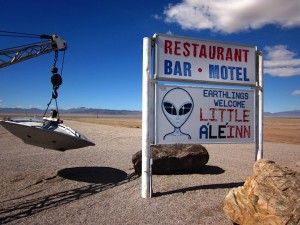 And then we drove a few more miles down the road and came to the “Black Mailbox,” which is sort of this mecca for alien hunters. It actually belongs to this poor guy who has to keep repainting it and putting his name back on because people come by and leave stickers and cell phone numbers and graffiti and messages to Fox Mulder all over it. We are out in the middle of nowhere at this point–none of the roads have signs and there are all these freakish cacti everywhere. We’re approaching the entrance. And the tour guide is really selling it–he’s telling us about the last guy he drove out here who made a run for it and unmarked black helicopters came swooping out of nowhere and arrested him. We’re excited. We have no idea what to expect.
And then we drove a few more miles down the road and came to the “Black Mailbox,” which is sort of this mecca for alien hunters. It actually belongs to this poor guy who has to keep repainting it and putting his name back on because people come by and leave stickers and cell phone numbers and graffiti and messages to Fox Mulder all over it. We are out in the middle of nowhere at this point–none of the roads have signs and there are all these freakish cacti everywhere. We’re approaching the entrance. And the tour guide is really selling it–he’s telling us about the last guy he drove out here who made a run for it and unmarked black helicopters came swooping out of nowhere and arrested him. We’re excited. We have no idea what to expect.
And we round a corner, we’re on this dirt road, and you can see where the road suddenly becomes paved. [See below.] And he stops the car and we get out and he’s like, this is it! It’s just this road. There are hills on either side and a few weather-beaten signs that say no trespassing. It was a little anti-climactic, to be honest. But there was an unmarked white jeep watching us from one of the hills, and this weird spindly camera thing clearly recording our every move from another. And the signs authorized whoever to shoot us on sight if we crossed onto the paved road. We took some silly pictures and headed back to the strip.
…Of course, this is all just what they told us to say.
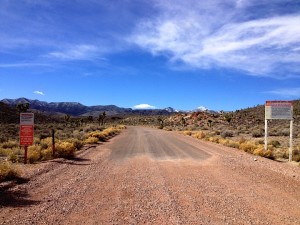 MARK: How’d you find this tour guide?
MARK: How’d you find this tour guide?
CAROL CATHERINE: You can find anything you want in Vegas.
MARK: Do you believe that Earth has been visited by beings from other planets?
CAROL CATHERINE: I’ll have to refer you to the current popular expert on these things: Mr. Neil DeGrasse Tyson. “[I]f our solar system is not unusual, then there are so many planets in the universe that, for example, they outnumber the sum of all sounds and words ever uttered by every human who has ever lived. To declare that Earth must be the only planet with life in the universe would be inexcusably bigheaded of us.”
MARK: Agreed. But do you think that we’ve been visited by beings from these other planets? Have they found us yet?
CAROL CATHERINE: I hope not – because if they have, only a few people know about it and that seems like a recipe for disaster. I do love listening to people talk about being visited by aliens though–like on Coast to Coast, or in the darkest recesses of the internet. There are so amazing stories out there. And after a while, you just really start wanting to believe them.
MARK: I think it was Stephen Hawking who said that sending Voyager out into the vast unknown as a giant beacon pointing other forms of intelligent life back to earth might not be such a good idea.
CAROL CATHERINE: I know–imagining what kind of alien race would be seeking us out at this point is a little bit terrifying. So many of my favorite books are science fiction, and so often the reasons we leave the planet in search of other worlds is because we’re hungry, desperate, and in need of a new home. I have to believe it’s far more likely that aliens would fall into that category than that they would be heavenly travelers bearing messages of peace. Although have you seen Interstellar? I don’t want to spoil anything, but that movie contained some truly beautiful ideas about outer space.
MARK: OK, I found the quote from Hawking: “If aliens visit us, the outcome would be much as when Columbus landed in America, which didn’t turn out well for the Native Americans. We only have to look at ourselves to see how intelligent life might develop into something we wouldn’t want to meet.”
CAROL CATHERINE: Ugh – yes! See? Terrifying. And also – and this is maybe related to Vegas, too – it really makes you think about what our legacy is. What defines us? What are we leaving behind? And depending on where the aliens land, how will that representation look to them?
MARK: You mentioned that your significant other is a conspiracy theorist. I’m curious as to his primary obsessions. Do you care to share the top three?
CAROL CATHERINE: Hah! I can’t just pick three. Ryan is perennially obsessed with many things, from NSA spying, to the American West, to surgical research. Wait, that is three. He is also obsessed with me. (*big cheesy grin*) Seriously, though, he’s shockingly well versed in such a wide variety of topics that I often–like, daily–just look at him and shake my head in wonder. He has such a voracious appetite for knowledge that it’s only natural he’d come to his own conclusions about most topics.
MARK: OK, so those are his primary obsessions, but what about conspiracy theories? Does he believe, for instance, that the moon landing was faked? How about the Kennedy assassination?
CAROL CATHERINE: I don’t think he believes either of those were faked…. you’ll have to ask him, and he’s going to hate that I’m outing him like this! I’ll just say that’s he’s a naturally curious and intelligent person who believes that there’s almost always more to the story than what the government shares publicly. And I have to say I agree.
MARK: Given what we’ve discussed thus far, I think you may find this of interest. I was just reading in the New York Times that there’s a formerer missile silo for sale in Roswell, New Mexico that would make a pretty incredible home.
CAROL CATHERINE: Wow. That’s amazing! What a bummer that it’s been so stripped down–have you seen this one? I will say that Ryan is a HAM radio aficionado, and there are plenty of guys that he’s spoken with who would snap that thing up in a heartbeat. I think the current term is “prepper.”
MARK: You mentioned that you had the best meal in your life in Vegas. What was it?
 CAROL CATHERINE: It was at Le Cirque, which is a legendary, and maybe overrated, restaurant in NYC–they have an outpost in the Bellagio. We splurged and got a five course meal before seeing Cirque De Soleil. It was such a perfect meal. I can’t even tell you what I ate. Has that ever happened to you? Like, such a totally perfect harmony of service and timing and portions and variety and decor and… it was magic. I do remember the dessert was a chocolate ball, which this fabulous white-mustachioed server poured molten chocolate over, and the shell melted away to reveal a perfect sphere of perfect ice cream. And then they presented me with a little red leather box full of chocolates, just because. I still have the box. [The remains of the chocolate ball seen right, with Ryan.]
CAROL CATHERINE: It was at Le Cirque, which is a legendary, and maybe overrated, restaurant in NYC–they have an outpost in the Bellagio. We splurged and got a five course meal before seeing Cirque De Soleil. It was such a perfect meal. I can’t even tell you what I ate. Has that ever happened to you? Like, such a totally perfect harmony of service and timing and portions and variety and decor and… it was magic. I do remember the dessert was a chocolate ball, which this fabulous white-mustachioed server poured molten chocolate over, and the shell melted away to reveal a perfect sphere of perfect ice cream. And then they presented me with a little red leather box full of chocolates, just because. I still have the box. [The remains of the chocolate ball seen right, with Ryan.]
MARK: Do you remember the worst vacation meal of your life?
CAROL CATHERINE: Good question… I’ve had some nasty hotel breakfasts on tour, that’s for sure. Maybe it’s a blessing that I can’t recall the worst of them right now. It was probably at a Perkins.
MARK: Back to Vegas, I’m curious to know if you looked into any of its underworld past. I know I said before that I saw the whole place as devoid of history, but the story of how Vegas came to be Vegas is really interesting… I just don’t know how much the real story of Vegas is told in the city itself. To be honest, though, I’ve never had time to seek it out.
CAROL CATHERINE: There are some wonderful museums in Vegas that do a great job of telling the origin story. There’s this one, the Neon Museum, that has this very cool “boneyard” of all the old casino signs, and our docent was full of anecdotes about who used to frequent the casinos and why. And you know, it’s a very young city, in its current form. Most of the people who have ever lived there are probably still alive. It’ll be interesting to see how the way we talk about Vegas changes as time goes by.
I want to harp on the “underworld past” part of your question, though. I think it’s a worthwhile question to ask, but I wonder how different the history of the city really is from a lot of the cities out west (and for that matter, most of our cities everywhere). I mean, the American government and renegade settlers succeeded in violently wiping out entire civilizations in the name of the expanding frontier. We have blood on our hands dating back to day one, so is it really so terrible that the Mafia set up a few casinos? It’s a tiny sugary rose on a giant genocidal cake.
The fascination and maybe disgust with the outward display of excess in Vegas seems a little silly to me, honestly. It’s just displaying the garish truth–Americans prioritize wealth over everything else. Like Hunter S. Thompson said, it’s the heart of the American dream. Maybe that’s cynical, but I see that reinforced over and over. If we have a problem with that, Vegas certainly isn’t the only place that should come under fire. [Carol Catherine and a horse below.]
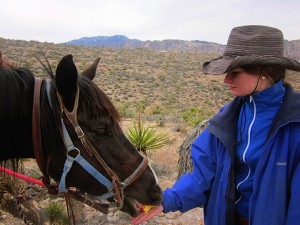 MARK: Why do you hate America?
MARK: Why do you hate America?
CAROL CATHERINE: Hah! I don’t! I just, you know, think there’s room for improvement. Ella Baker has a fantastic quote that sums it up for me: “The best country in the world, they say. May be, I haven’t really lived anywhere else. But it’s not good enough as far as I am concerned.”
MARK: In all seriousness, you’re right when you say that all cities have ugly pasts. Every American city that I’m aware of was built on the ruins of a native community that was systematically destroyed. Our history is one of murder and ugliness. The thing that fascinates me about Vegas, though, it how recent it all happened. I mean, I know there was a town before the Hoover Dam was built, but it’s like the city sprang up overnight with the influx of 20,000, almost exclusively male, workers. (The population of Vegas jumped from 5,000 to 25,000 in 1931.) From Wikipedia…. “A combination of local Las Vegas business owners, Mormon financiers, and Mafia crime lords helped develop the casinos and showgirl theaters to entertain the largely male dam construction workers.” I find that fascinating.
CAROL CATHERINE: Totally fascinating, I agree. And I’ve read statistics that put the population growth at 650% over the last 50 years. I mean, that is insane. And brings with it a host of issues, not the least of which are environmental. I read about the health impacts of air pollution all day long for my university job, and rapid urban growth produces an alarming amount of particles that can be harmful, especially to pregnant women, infants, and individuals with pre-existing conditions. What intrigues and excites me, though, about that growth, as a public health researcher, is the opportunity to develop policy and programmatic responses that allow for sustainable growth and stewardship of the natural environment. I know, for example, that Nevada is the top solar energy producer in the country, and that they are throwing a lot of money behind renewable energy development. There are good things happening there. People care and people are working hard to preserve and sustain the desert. I don’t know. The city, the strip–it’s ridiculous and overblown and represents a certain stubborn self-destructiveness–and yet, it’s this incredibly creative, beautiful city with so much potential. It isn’t just one or the other–it’s both.
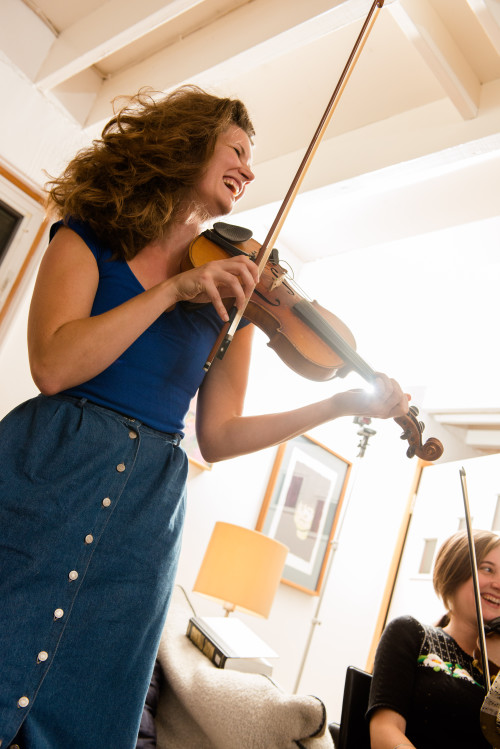
[Photo by Doug Coombe.]
MARK: On the other side of the equation, these are people living in the desert, and no matter what you do, you can’t make that sustainable. I’m inclined to say that we should let the desert devour it, and move people to a place more hospitable to human life. With that said, maybe we can learn things in Vegas that will help people prepare for the colonization of Mars.
CAROL CATHERINE: Colonizing Mars – I’m all about it. I think we should be careful to note that there are in fact sustainable ways of living in the desert, but western health and habits are not well-suited to that lifestyle. I know there were plenty of native people who thrived for hundreds of years in arid climates before white people “discovered” those areas. It might be that the desert does need to swallow Vegas, and many other sprawling, wealthy cities (like Phoenix, for example) for us to actually have a shot at sustaining communities there over the long term. Radical change is necessary to move forward.
I really do still love Vegas, though. I love it like I love my air conditioner, like I love my soft, comfy clothes made in third world countries, like I love my access to all kinds of fruits, meats, and vegetables that by all rights I should not be able to eat this time of year. All of these things are easy to love when you don’t start to unpack them and look at the larger systems in place that are harmful and destructive. But there is no place on earth like Vegas – and for that reason, I’m glad I got to see it now, while it, and we, are still around.
[When not performing with Saturday Looks Good to Me, Misty Lyn & the Big Beautiful and Matt Jones & the Reconstruction, Carol Catherine can be found acting with the likes of the Ann Arbor Civic Theater, Shakespeare in the Arb and the RC Players, whose production of “The Illness Narratives,” a partly student-written collection of monologues and scenes about living with disease, will be debuting this Easter.]
[Thank you to Doug Coombe for all of the incredible performance photos.]
[And, if you want to read about the vacations of other Michigan musicians, just click here.]
 This coming Saturday’s show, if nothing else, will be eclectic. Among others, we’ll be talking with hip hop artist and philosopher Brandon Mitchell (aka MC Kadence), Colin Moorhouse from the local zine Ypsi Underground, and a group of folks who will be coming by the AM 1700 studio to discuss the possibility of an on-air food challenge of some kind. And, as if that weren’t enough, the multi-talented Jim Cherewick, who wrote the theme song for last week’s show, will be in the studio with his pens, drawing everyone who drops by to visit. And, on top of all that, your favorite Ypsi bar manager, Brigid Mooney, will be coming by at some point to introduce us to one of her funnier regulars. And we’ll be kicking the whole thing off by talking with Morgan Cox, from FLY Children’s Art Center, who has offered to supply this week’s six pack. (Thank you, Morgan.) Oh, and we also just hired our first Saturday Six Pack reporter, who will be on the street come Saturday night, looking for downtown Ypsi action to report on. So be sure to tune in come 6:00. It should be fun.
This coming Saturday’s show, if nothing else, will be eclectic. Among others, we’ll be talking with hip hop artist and philosopher Brandon Mitchell (aka MC Kadence), Colin Moorhouse from the local zine Ypsi Underground, and a group of folks who will be coming by the AM 1700 studio to discuss the possibility of an on-air food challenge of some kind. And, as if that weren’t enough, the multi-talented Jim Cherewick, who wrote the theme song for last week’s show, will be in the studio with his pens, drawing everyone who drops by to visit. And, on top of all that, your favorite Ypsi bar manager, Brigid Mooney, will be coming by at some point to introduce us to one of her funnier regulars. And we’ll be kicking the whole thing off by talking with Morgan Cox, from FLY Children’s Art Center, who has offered to supply this week’s six pack. (Thank you, Morgan.) Oh, and we also just hired our first Saturday Six Pack reporter, who will be on the street come Saturday night, looking for downtown Ypsi action to report on. So be sure to tune in come 6:00. It should be fun. 













